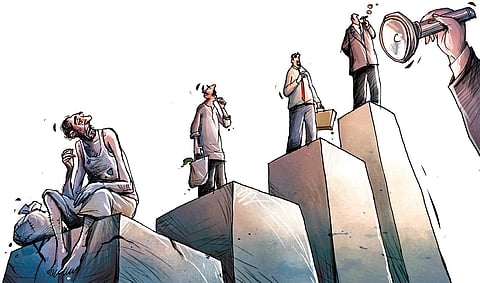

Much like retailers and architects, economists too can exult, “Location, location, location.” Consider a finding by Branko Milanovic, an economist who has extensively analysed data on global income distributions. He concluded that 60 percent of a person’s income is determined by her or his country of birth, and another 20 percent by the income of her or his parents.
A study of income inequality within the Organisation for Economic Cooperation and Development countries arrived at a similar conclusion. With 70 percent probability, a lagging region continues to lag behind well-off regions.
The assertion is true for India. Despite becoming a $3-trillion economy, the country’s per-capita income is a fraction of that in some advanced countries, and it is far from catching up. This would explain why, given an opportunity, Indians migrate in search of greener pastures. They assume a link between location and income.
It’s true within India, too. It is well recognised that income in the poorer states is not growing faster than in the richer states. A less recognised fact is the persistence, if not widening, of disparities within states and, in particular, within the relatively more urbanised and richer states.
The average monthly per capita consumption expenditure of rural households in eastern Maharashtra is 35 percent lower than those in Coastal Maharashtra or the Konkan Region. This difference is even starker if we consider urban households—it is lower by half. These estimates are from the 2017-18 survey of consumption expenditure. Though the Centre did not release the data that was collected, late last year, the Maharashtra government did release some key estimates from the survey.
The differences in consumption expenditure did not come as a surprise because Maharashtra’s annual economic survey shows no convergence in per capita district domestic products—in the Konkan region it is over `3 lakh, which is nearly twice that in the Amravati region.
In adjoining Karnataka, the average income in the northern districts continues to lag behind the southern districts. At the risk of oversimplifying, one could say that it is better to be born in southern Karnataka or coastal Maharashtra rather than in other parts of these states.
Do we have a fair understanding of why certain regions stay behind others? More often than not, the answer is traced to inadequate development expenditure and educational infrastructure.
This thinking of divergence is evident in the Constitution of India. Article 371 seeks to address inequities within a state. But what does the Article, which has special provisions on states, have to say on the way forward in Maharashtra and Karnataka? Based on the provisions in Article 371(2), development boards were constituted for Vidarbha, Marathwada and the rest of Maharashtra. These boards are supposed to ensure “equitable allocation of funds for developmental expenditure” and “an equitable arrangement providing adequate facilities for technical education and vocational training, and adequate opportunities for employment in services under the control of the state government, in respect of all the said areas”. Based on the advice of Article 371(J), the Hyderabad-Karnataka Region Development Board was constituted in Karnataka.
The background work done before constituting the development boards clearly established the persistence of large intra-state differences. But how do we measure progress? A high-level committee on balanced regional development issues in Maharashtra in 2013 pointed to the lack of data and, where available, had to use data which were not always comparable across regions and over time. What is ironic here is that the Maharashtra experience was portrayed as a success during the discussion on amending the Constitution in order to facilitate the creation of the Hyderabad-Karnataka Region Development Board.
Though development boards came into existence in Maharashtra and Karnataka in 1994 and 2013, they are far from fulfilling their objectives. There is no database for evaluating why they have failed. A development board is supposed to be temporary. Maybe we do not need them if we strengthen the third tier of the government. This points to the need for a white paper on the purpose development boards actually serve. It matters because the output of each district contributes to the state domestic product, and the states together determine India’s gross domestic product.
A lot has been written on the weakness of the national statistical system, though it is equally important to strengthen state statistical systems. Rather than top-down, what is required is a bottom-up approach starting with the third tier of the government. State governments have Departments of Economic Statistics, but in my view they lack strategic planning. Not only will this require adequate budgets but also professionals at the helm. Just as every state has a chief secretary, why not let each state have a chief statistician?
Another reason for strengthening state statistical systems is that they provide data for the work undertaken by the state finance commissions. The constitution of a state finance commission is a constitutional requirement. It is supposed to make recommendations on the allocation of financial resources within the state. The allocation formula is supposed to take into account intra-state disparities. However, their working has been hampered by a lack of village-, city- and district-level data.
So, while we have been bemoaning the fact that the government has been slow in releasing data and conducting the census, we also need to recognise that we do not have adequate data for the smooth functioning of institutions that we have already had to mandatorily set up.
Politicians do realise that where you live matters—it determines health and education, employment opportunities and future income. So, the Lok Sabha elections should be about bridging intra-state and inter-state disparities. Some parties are now promising a caste census. But to what end? There are not enough government jobs available for reservation to be meaningful. The courts are not inclined to permit state governments to legislate domicile-based reservation of jobs in the private sector. Like for statistical systems, let’s chart the course before starting down a road.
S Chandrasekhar
Professor, Indira Gandhi Institute of Development Research, Mumbai
(Views are personal.)